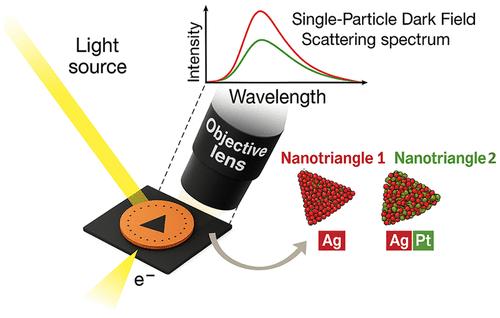双金属等离子体纳米粒子的结构与性能分析
IF 3.2
3区 化学
Q2 CHEMISTRY, PHYSICAL
引用次数: 0
摘要
双金属等离子体纳米材料通过控制其组成和结构,为定制光学和催化功能提供了独特的机会。它们的性能源于等离子体主金属和功能次级成分之间的相互作用,但要解开合金和形貌如何影响它们的光学响应仍然具有挑战性,特别是当它们的光学特性通常在体尺度上测量时。在此,我们对不同形状和铂含量的Ag和AgPt纳米颗粒(NPs)进行了系统的单粒子研究,所有这些纳米颗粒都是在相同的条件下在单个碳涂层TEM网格上测量的。利用结合暗场显微镜、单粒子散射光谱、扫描透射电子显微镜(STEM)和能量色散x射线光谱(EDS)的相关成像方法,我们直接将结构和成分特征与单个粒子水平的光学行为联系起来。我们的数据集包括Ag和Ag1-xPtx (x = 0.02, 0.035和0.1)纳米球,纳米片和三角形纳米颗粒(TNPs),其中AgPt纳米颗粒通过电替换合成。相同的网格配置可以在光学和结构模式中一对一地跟踪粒子身份,从而避免样品与样品之间的差异造成的伪影。我们观察到等离子体响应的成分和几何变化,通过有限元方法(FEM)模拟证实,这表明合金和形貌如何调制光学散射。这项工作为解决能量转换应用背景下双金属等离子体纳米结构中的结构-性质关系建立了一个强大且易于访问的框架。通过在成分和形态之间进行可控的比较测量,我们的方法为纳米级等离子体调谐提供了见解,并支持下一代双金属材料的合理设计。本文章由计算机程序翻译,如有差异,请以英文原文为准。

Structure–Property Analysis of Bimetallic Plasmonic Nanoparticles Using Correlative Optical and Electron Microscopy
Bimetallic plasmonic nanomaterials offer unique opportunities for tailoring optical and catalytic functionality through controlling the composition and structure. Their performance arises from the interplay between a plasmonic host metal and a functional secondary component, yet disentangling how alloying and morphology influence their optical response remains challenging, particularly when their optical properties are commonly measured on the bulk scale. Here, we present a systematic single-particle study of Ag and AgPt nanoparticles (NPs) with varying shapes and platinum contents, all measured under identical conditions on a single carbon-coated TEM grid. Using a correlative imaging approach that integrates dark-field microscopy, single-particle scattering spectroscopy, scanning transmission electron microscopy (STEM), and energy-dispersive X-ray spectroscopy (EDS), we directly link structural and compositional features to optical behavior at the individual particle level. Our data set includes Ag and Ag1–xPtx (x = 0.02, 0.035, and 0.1) nanospheres, nanodiscs, and triangular nanoparticles (TNPs), with the AgPt NPs synthesized via galvanic replacement. The same-grid configuration enables a one-to-one tracking of particle identity across optical and structural modalities, thereby avoiding artifacts from sample-to-sample variability. We observe composition- and geometry-dependent changes in plasmonic response, confirmed by finite element method (FEM) simulations, which demonstrate how alloying and morphology modulate optical scattering. This work establishes a robust and accessible framework for resolving structure–property relationships in bimetallic plasmonic nanostructures in the context of energy conversion applications. By enabling controlled comparative measurements across compositions and morphologies, our approach provides insights into nanoscale plasmonic tuning and supports the rational design of next-generation bimetallic materials.
求助全文
通过发布文献求助,成功后即可免费获取论文全文。
去求助
来源期刊

The Journal of Physical Chemistry C
化学-材料科学:综合
CiteScore
6.50
自引率
8.10%
发文量
2047
审稿时长
1.8 months
期刊介绍:
The Journal of Physical Chemistry A/B/C is devoted to reporting new and original experimental and theoretical basic research of interest to physical chemists, biophysical chemists, and chemical physicists.
 求助内容:
求助内容: 应助结果提醒方式:
应助结果提醒方式:


